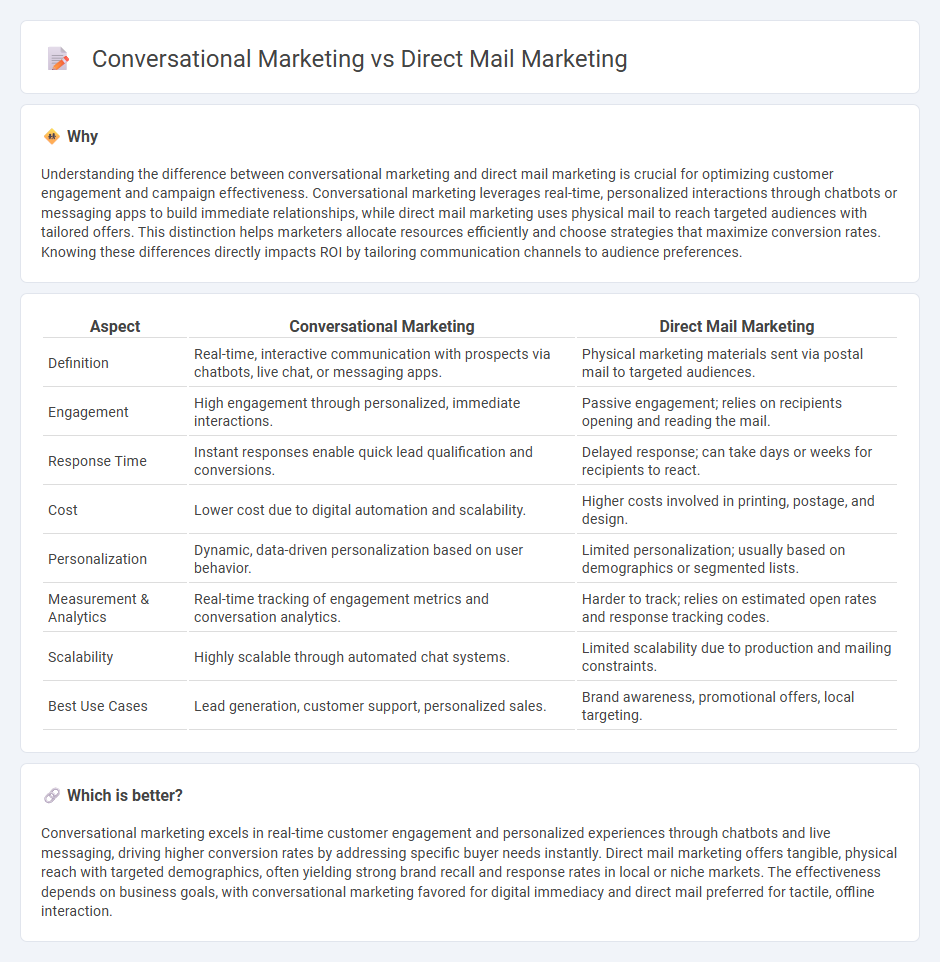
Conversational marketing leverages real-time, personalized interactions through chatbots and messaging apps to engage customers and drive sales, while direct mail marketing relies on sending physical promotional materials to targeted audiences for brand awareness and response generation. Both strategies aim to enhance customer engagement but differ significantly in immediacy and personalization. Explore the unique benefits and applications of conversational marketing versus direct mail marketing to optimize your marketing efforts.
Why it is important
Understanding the difference between conversational marketing and direct mail marketing is crucial for optimizing customer engagement and campaign effectiveness. Conversational marketing leverages real-time, personalized interactions through chatbots or messaging apps to build immediate relationships, while direct mail marketing uses physical mail to reach targeted audiences with tailored offers. This distinction helps marketers allocate resources efficiently and choose strategies that maximize conversion rates. Knowing these differences directly impacts ROI by tailoring communication channels to audience preferences.
Comparison Table
| Aspect | Conversational Marketing | Direct Mail Marketing |
|---|---|---|
| Definition | Real-time, interactive communication with prospects via chatbots, live chat, or messaging apps. | Physical marketing materials sent via postal mail to targeted audiences. |
| Engagement | High engagement through personalized, immediate interactions. | Passive engagement; relies on recipients opening and reading the mail. |
| Response Time | Instant responses enable quick lead qualification and conversions. | Delayed response; can take days or weeks for recipients to react. |
| Cost | Lower cost due to digital automation and scalability. | Higher costs involved in printing, postage, and design. |
| Personalization | Dynamic, data-driven personalization based on user behavior. | Limited personalization; usually based on demographics or segmented lists. |
| Measurement & Analytics | Real-time tracking of engagement metrics and conversation analytics. | Harder to track; relies on estimated open rates and response tracking codes. |
| Scalability | Highly scalable through automated chat systems. | Limited scalability due to production and mailing constraints. |
| Best Use Cases | Lead generation, customer support, personalized sales. | Brand awareness, promotional offers, local targeting. |
Which is better?
Conversational marketing excels in real-time customer engagement and personalized experiences through chatbots and live messaging, driving higher conversion rates by addressing specific buyer needs instantly. Direct mail marketing offers tangible, physical reach with targeted demographics, often yielding strong brand recall and response rates in local or niche markets. The effectiveness depends on business goals, with conversational marketing favored for digital immediacy and direct mail preferred for tactile, offline interaction.
Connection
Conversational marketing and direct mail marketing connect by leveraging personalized communication to enhance customer engagement and drive responses. Direct mail campaigns often include call-to-action prompts that initiate real-time conversations through chatbots, messaging apps, or phone calls, creating an interactive customer journey. Integrating conversational marketing strategies with direct mail increases conversion rates by delivering tailored experiences based on immediate customer feedback and preferences.
Key Terms
Personalization
Direct mail marketing leverages tailored physical content delivered to targeted audiences, enhancing engagement through personalized messages and visuals. Conversational marketing prioritizes real-time, interactive communication via chatbots and messaging platforms, enabling dynamic customer experiences based on individual preferences and behaviors. Explore how these personalized strategies can significantly boost customer connection and conversion rates.
Response Rate
Direct mail marketing boasts an average response rate of 4.9%, significantly higher than the 1-2% typical in many digital campaigns, driven by its tactile and personalized nature. Conversational marketing leverages real-time interactions via chatbots and messaging apps, leading to faster engagement and conversion, often achieving response rates up to 5-10% depending on industry and implementation. Explore detailed statistics and strategies to optimize both marketing approaches for maximum response impact.
Engagement
Direct mail marketing leverages personalized physical mail to create tactile engagement, often yielding higher response rates through tangible touchpoints. Conversational marketing uses real-time, interactive digital communication such as chatbots and live chats to foster immediate dialogue and build rapport with potential customers. Explore the strengths of each approach to optimize your engagement strategy effectively.
Source and External Links
Direct mail marketing - Mailchimp - Direct mail marketing is a form of physical direct marketing sent to prospects via postal or delivery services, offering a broad reach especially for audiences less engaged online, and allowing creative, tactile marketing approaches that can integrate with digital campaigns for greater impact.
A Beginner's Guide to Direct Mail | USPS Delivers - This guide explains how to plan and execute a direct mail campaign step-by-step, from defining business objectives and targeting the right audience to designing mailpieces and measuring campaign success.
Direct Mail Marketing Services | DirectMail.com - DirectMail.com offers comprehensive direct mail marketing solutions including creative design, data-driven audience targeting, integrated omni-channel campaigns, and automation to help businesses grow and boost ROI with personalized multi-channel engagement.
 dowidth.com
dowidth.com